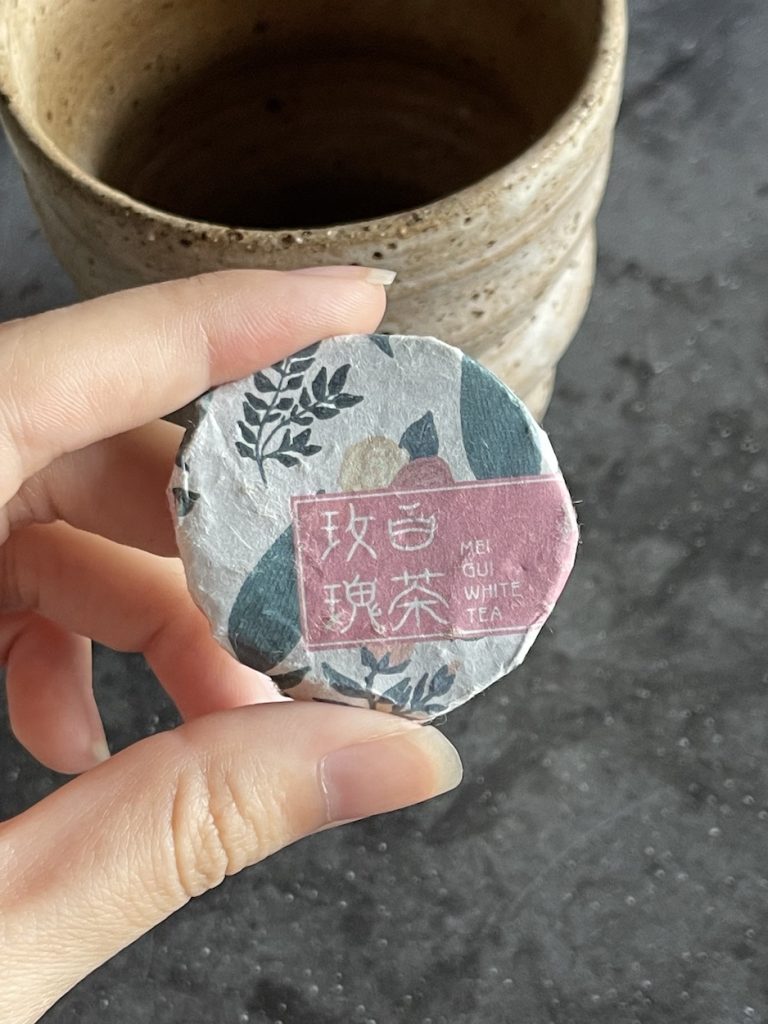Another week, another quick tea review! I’ve been thoroughly enjoying the lack of pressure involved in these quick tea reviews, though I don’t actually know how much I’m “learning” about Chinese tea given the free and easy approach!
But so far, I’ve found out that the tea samples I received are either white tea or puer – there doesn’t seem to be much black, oolong, or green teas inside. But let’s start with the reviews:

白茶珍藏 (Chenpi White Tea): looks pretty dark, wonder if it’s been aged. The tea from the first steep is very light (tea cake hasn’t opened up at all) and just tastes slightly sweet. As the tea continues to be steeped, the sweetness intensifies into a fruity sort of sweetness which is very pleasant. The tea cake became completely loose after about 3 or 4 steeps and the sweetness has also mellowed out around then. Sometimes I get an additional note I can only describe as “peppery” though it’s not a savoury tea at all! Looking at the spent leaves, which do smell a bit peppery, I see lots of mandarin peels! Perhaps that’s where the fruity sweetness was from?


Whole chenpi puer: I was a bit worried the tea had gone bad when I opened up the packet and saw something white on the peel, but a quick google told me that was the sugars from the mandarin and nothing to be worried about. Compared to the chenpi white tea, this is a whole different thing – it’s got a very strong and sweet citrus note because the tea is stuffed into the fruit. By comparison, the puer takes a back seat in this tea. Personally, I prefer this way because I really love the intense chenpi flavours!


玫瑰白茶 (Rose White Tea):The leaves look dark but I can see the rose petals inside. The first two steeps tasted sweet and light but I couldn’t get the rose notes. I was wondering how long the rose would take and the answer is: after the tea cake is loose! That was about the third steep and it’s worth it. The rose goes well with the sweetness of the white tea and doesn’t overpower the tea at all.
Rose Puer: I think this is a ripe puer, but I’ll have to admit I can’t tell for sure. The tea cake smells like roses and the first steep looked and tasted very light. The tea cake loosened very quickly and the second steep was much darker. Sadly, unlike the rose white tea, the rose notes weren’t very strong here – I suspect it’s because of the brewing time. I could let the tea steep for longer but I didn’t because it brewed really quickly.

糯香龙珠 五年陈 (Five Year aged glutinous dragon pearl):This one looked and smelled like a ripe puer. The first steep was already light brown/orange and I could see that the smaller leaves have broke off. The tea tastes sweet and “starchy” and I got a glutinous rice note. The tea liquor is a very dark colour by the second steep and the leaves are loose. Surprisingly, the sweetness was much more muted in the second cup, though the tea was still smooth and now somewhat earthy like a ripe puer. At first, I wondered if the sweetness was only for the first few steeps but then I realised it was a temperature issue – brewing the tea with freshly boiled water made it sweeter. The tea was slightly drying in the mouth and ironically made me thirsty. I liked this better than the other glutinous rice puer but probably because it felt a lot more like a regular ripe puer.
I didn’t intend to compare two variations of the same tea (the chenpi and rose) but I’m glad I did! I think rose pairs well with white tea and chenpi tastes best when you stuff the tea in it rather than mix the peel with the tea, but that’s just my preference.
